Any school in South Korea can be considered a good one. After all, South Korea has some of the highest rates in literacy, sciences, and mathematics, among OECD countries on its Program for International Student Assessment ( PISA ), and essentially in the whole world. In fact, it is said that South Korea has a 100% literacy rate producing gifted students!
Thus, it is incredibly interesting to learn more about Korean schools and understand better why the South Korean education system is regarded so highly. In this article, we will explain to you what school is like in South Korea.
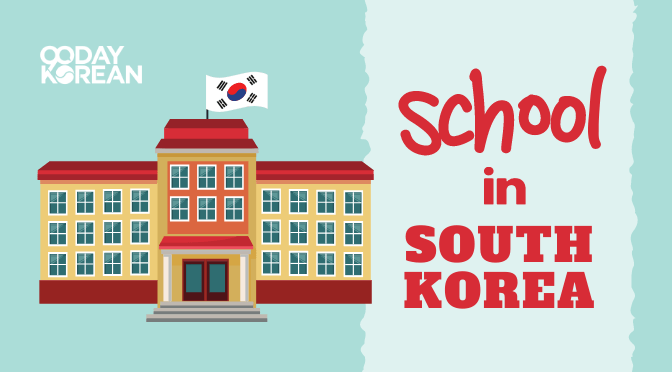
What is school like in South Korea?
South Korea has the highest percentage in the entire world – 70% to be specific – in regards to people aged 24 to 35 that have completed some type of education beyond high school. That may mean a university degree or higher in university, or completing a shorter program in a polytechnic, or something else equivalent.
The standard of Korean education is really high and public and private schools both provide a great quality of teaching. The basic construction of Korea’s education system is as follows: The compulsory education is composed of six years in primary school (elementary school) and three years in middle school, and three years in high school.
South Korea also has a national curriculum developed by the Ministry of Education. They also monitor this national curriculum which is revised every five to ten years reflecting the changes happening in Korean society.
When does school start in Korea?
There are two semesters in each school year, the first one running from March to July, and the second one from September to February. While summer and winter holidays exist, there are 10 optional half days of school at the beginning and end of each holiday break, and the majority of the Korean students attend both.
How much do students study in South Korea?
It is common for Korean students of any schooling level to attend private schools and/or receive tutoring outside of official school hours. For primary and secondary schools, the number of classes taken is typically less, as well as less rigid, than they are for high schools.
There are also more recreational activities and classes, such as taekwondo or piano or cooking and baking, included in their schedules than there are for high schoolers.
What is the school system in South Korea?
Although there has been some push for change over the years, especially recently, as of right now the Korean school system is highly test-driven. In general, which middle school, high school, and university the student went to has a major influence on future career opportunities. That is one major reason why students even from primary and secondary schools already receive tutoring lessons and go to private schools.
However, the Korean government has been making efforts as of late to reduce the pressure and stress put on Korean students through the current education system. In some regions, there are limitations to the operating hours of private schools – better known as hagwon (학원 in Korean) or cram schools. There is also an exam-free school year system put to place in middle school. Only time will tell whether these efforts will work.
Overall, Korea’s education system is seen as one of the most rigorous ones in the world with its goal to efficiently prepare students for their future careers. It certainly does have the largest private tutoring industry out there. Also, a lot of the top-ranking Korean government officials and big company management positions are also currently mostly held by university graduates from top-tier Korean universities.
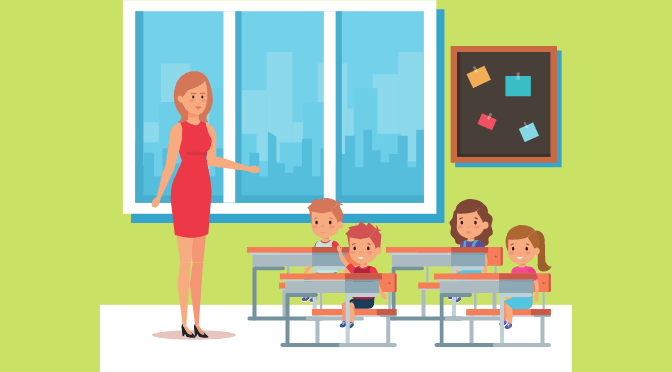
Teachers in South Korea
Teachers in South Korea are typically highly respected by the general public. It’s not without reason, as they are also highly educated in their profession and often get into universities in South Korea from top high schools. Those seeking to become teachers must also attend a university specialized in education.
For people who aim to teach in primary school, they must also major in primary education which is specifically created to develop future primary school teachers. There are also only very few institutions in Korea for training primary school teachers. However, unlike primary education, there are more training institutions and programs dedicated to secondary school teachers.
Foreign Language learning in South Korea
A foreign language like English is taught at various levels in Korea. Young primary school students from public and private schools are already taught English.
At the university level, foreign language learning is becoming increasingly important. In the top universities, already more than 30% of courses are taught in English now. In general, English is seen as one of the most prioritized school subjects to learn, with private tutoring and hagwon classes offered from as early on as kindergarten.
Thus a lot of money has also gone into this foreign language learning, both by the Korean government and by the families themselves.
Is school free in South Korea?
Primary and secondary schools are free in South Korea. Also, in order to promote equality, middle school students are placed into schools based on the districts they live in, through a computer lottery system. However, unlike previous levels of schooling, high school is not free in Korea. It is also not mandatory to attend.
Education Levels in South Korea
There are different levels of education in South Korea starting from elementary school, all the way up to university. To add, Korea also accommodates international students through international schools.
Elementary school in South Korea
In South Korea, attending school at the primary school level is free of charge at its public education, beginning at the age of 6. Prior to entering primary school, nearly every child attends some form of preschool and kindergarten.
School subjects studied by primary school students are as follows: Korean language, mathematics, ethics, social studies, English, science, arts, music, and physical education.
In recent years, efforts have been made for primary schools to move away from the multiple-choice question-only exams and to introduce essay writing and creative thinking into exams and testing instead.
Middle school in South Korea
In South Korean middle schools, the curriculum is constructed of 12 subjects, some of which are basic and mandatory for all, and some of which are electives and extracurricular activities.
Middle school teachers all have their own subjects they are specialized in teaching. Much of the subjects are the continuation of what the children were taught in elementary school namely the Korean language, mathematics, ethics, social studies, English, science, arts, music, and physical education.
However, in addition, middle school students also get to choose between studying technical education or home sciences.
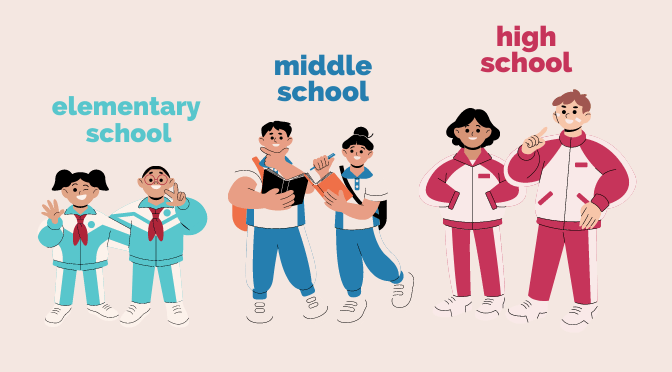
High school in South Korea
There are nine primary subjects taught during high school in Korea. These subjects are Korean language, social studies (including Korean history), mathematics, science, physical education, fine arts, practical arts, and moral education.
How are high schools categorized in South Korea?
High schools in Korea are divided into these different categories.
By gender
The majority of high schools in South Korea still continue to be boys only or girls only today, although the amount of co-ed high schools has been on the rise. The high schools follow a standardized curriculum, which means that boys and girls study the same subjects, even if they attend Korean schools separated by gender.
Academic and vocational high schools
High schools are also divided between academic high schools and vocational schools. More than half of them are still of the academic type focusing on academic performance. There are also a few high schools that are specifically specialized in focusing on sports, science, arts, or foreign languages, among other fields of specialization.
The vocational high schools, on the other hand, offer an education system focusing on employment. The majority of South Korean students enroll in regular high schools.
Elite high schools in Korea
Lastly, there are also some high schools that are designated autonomous in what type of curriculum they have to offer. These are typically seen as elite institutions which are focused primarily on preparing students to get into the very top universities. Therefore, lately, they are meeting a lot of scrutiny and criticism from the Korean administration, and they may end up getting converted into regular high schools.
High school admission
For 60% of the high schools, admission happens based on a lottery system, similar to middle schools. However, the rest of the high schools have a highly competitive admission process, selecting students based on GPA, entrance exams, interviews, and recommendations by teachers.
What to expect in Korean high schools?
A typical school day in high school begins at 8 am, and finishes between 4 pm and 4:50 pm. Each class runs for 50 minutes, as does lunch break. High school students usually remain in the same schoolroom for the duration of the day, with teachers rotating room to room based on which class they are teaching the subject to.
The subjects taught in regular high school are largely the same as the subjects under middle school education. In the 11th and 12th grades, high school students additionally get to choose elective subjects to learn. These include various sciences like physics, chemistry, and geography, or even economics or politics, or foreign languages.
However, while the actual school day finishes in the late afternoon, it is normal for high school students to attend more classes, either at private academies or through tutoring sessions, until as late as midnight. Of course, they do get to have a dinner break in between. Thus, it is not uncommon to hear of high school students studying as much as 16 hours on some days.
Vocational education
Meanwhile, in vocational high schools, the students study the standard academic curriculum for the first year, before moving on to studies specializing around their choice of vocational field. These include agriculture, business, fishery, engineering, technology, and marine transportation.
Most of the vocational high schools use modules developed by the Korea Research Institute for Vocational Education and Training the Ministry of Education. By graduating from vocational schools, students do still have access to universities but fewer choose to pursue such a path. Instead, they are more inclined to choose a shorter program at junior colleges.
Meister schools (Vocational Education Programs)
4% of high school-aged students in South Korea also currently attend school programs known as Meister schools. It’s a type of vocational school where students learn of industries such as banking, social services, dentistry, and semiconductor development. The curriculum at these vocational secondary schools is conducted in cooperation with local companies, lectures offered by experts in the industries, and internships included in the study programs.
These vocational schools exist as an effort from the Korean government to push more students into the labor market directly from high school. Therefore the graduates from Meister schools are not allowed to enter university until after having worked for at least three years. However, upon completing the three years of full-time work, it’s easier for them to have a university degree in comparison to their peers.
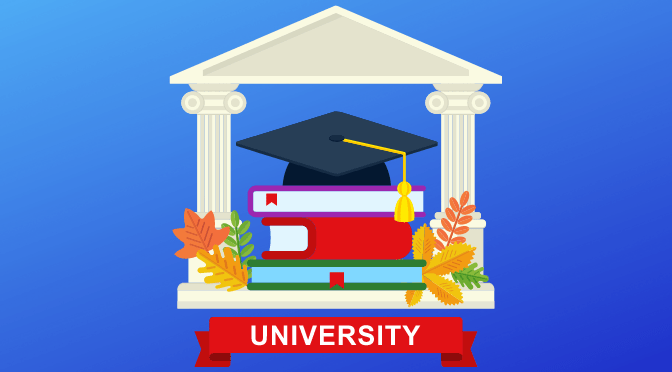
University in South Korea
In South Korea today, university graduates from a prestigious university like the Seoul National University are still at advantage, since where a student has graduated from still holds a lot of importance in hunting for a job.
University admission
Universities accept students based on their test scores from admission exams. However, other means of admission to universities are also considered.
수능 (Suneung)
To enter, students must complete the Suneung (수능) exam, officially known as the “National University College Scholastic Ability Test”. In total the exam lasts for 8 hours, is mostly constructed of multiple-choice questions, and allows access to apply for 3 universities.
This exam takes place each November, and it is such a major national event that even businesses will open later that day to ensure that every student taking the exam will be able to get to the testing site on time. Even air traffic is suspended as the students take the listening part of the examination.
There are 9 subjects tested during the exam, with the students having some options of which subjects they will take the exam in. The Korean language is the only subject that is mandatory for everyone. This exam is seen as one of the toughest university entrance exams in the world.
Other ways of admission to a university
Although the Suneung exam is of major importance, universities additionally look at various other criteria when choosing their students. These include university-specific admission tests, high school GPA, recommendation letters, and more. The Korean government, on the other hand, is trying to push the universities to emphasize the Suneung exam over other criteria in their student selection process.
Additionally, the government is also requiring special admissions of students from rural areas. This is because they have less access to private tutoring and academies, which in turn result in lower score results from Suneung, putting them otherwise at disadvantage with university admission.
University degrees and higher education
Bachelor’s degrees take four years to complete and are possible to follow up with master’s degrees lasting two years, and doctoral degrees. In the case of a doctoral degree, it may be constructed together with a master’s degree, or it may be a separate degree.
Alternatively, it is possible to obtain a shorter associate degree from junior colleges. Most students try to achieve some sort of higher education before starting their working lives.
Universities in South Korea
There are more than 400 universities, junior colleges, and other higher education institutions in South Korea at the present time. The vast majority of the most prestigious universities are located in the capital area, including universities such as Yonsei University and Korea University. Tuition fees are roughly $8,500 USD per year, although the specific figure depends on the university and department, with various scholarships available for South Korean and foreign students.
Specialized universities
Most of the universities comprise multiple departments, ranging from business to technology. However, some specialized universities exist as well, with KAIST (Korea Advanced Institute of Science and Technology) as the most notable one of them. This university also ranks 22nd in the World University Rankings.
Each degree comprises core subjects mandatory for every student, elective general subjects, and then both mandatory and elective subjects focused around the major. A student must complete 130 credits in order to qualify for graduation.
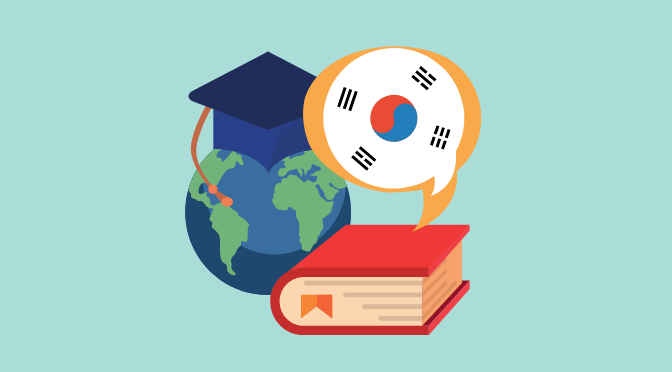
International Schools in South Korea
There are also international schools in South Korea. There are more than 40 international schools to accommodate qualified international students, as well as Korean students. However, enrolling in an international school is not open to everyone.
To be qualified as a student in international schools, one must either be a Korean national who has lived abroad for at least three years, or the student must be a child of a foreign national.
And that would be the Korean education system and school in South Korea in a nutshell! How does the South Korean education system compare to your country’s? Do you also have plans of studying in universities like Seoul National University or Korea University? How much of this content did you already know and what was new information? Let us know below in the comments!
The post School in South Korea – Learn about their education system appeared first on 90 Day Korean®.
 Learn to read Korean and be having simple conversations, taking taxis and ordering in Korean within a week with our FREE Hangeul Hacks series: http://www.90DayKorean.com/learn
Learn to read Korean and be having simple conversations, taking taxis and ordering in Korean within a week with our FREE Hangeul Hacks series: http://www.90DayKorean.com/learn
Korean lessons * Korean Phrases * Korean Vocabulary * Learn Korean * Learn Korean alphabet * Learn Korean fast * Motivation * Study Korean


Recent comments